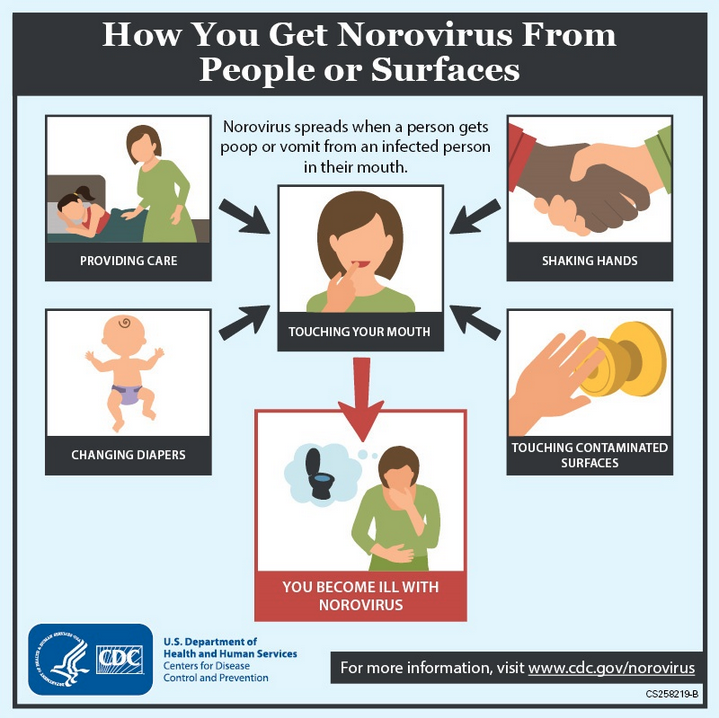When people think of health issues on cruise ships, their minds usually go to outbreaks of norovirus. That’s a highly contagious virus, typically spread by the fecal-oral route, which causes gastrointestinal symptoms such as diarrhea, vomiting, nausea and stomach pain.

However, it’s not just communicable diseases that can potentially make people sick on a cruise ship. Anything that can have an effect on public health – food handling, a ship’s potable water system, certain maintenance issues, ventilation, care of bodies of water such as pools and hot tubs, proper cleaning of uniforms and costumes, and the list goes on and on – can all affect the well-being of a cruise ship’s passengers and crew.
Obviously, the CDC wants to ensure passengers’ safety on cruise ships departing from U.S. ports. Not surprisingly, so does the cruise industry since each company wants to keep its reputation clean. So, the two entities have developed a Vessel Sanitation Program (VSP) and a VSP Operations Manual.
HHS/CDC established the Vessel Sanitation Program (VSP) in the 1970s as a cooperative activity with the cruise ship industry. VSP helps the cruise ship industry prevent and control the introduction and spread of environmentally associated illnesses and hazards on cruise ships. VSP operates under the authority of the Public Health Service Act (Section 361 of the Public Health Service Act; 42 U.S.C. 264, “Control of Communicable Diseases”). Regulations found at 42 CFR 71.41 (Foreign Quarantine—Requirements Upon Arrival at U.S. Ports: Sanitary Inspection; General Provisions) state that carriers arriving at U.S. ports from foreign areas are subject to sanitary inspections to determine potential rodent, insect, or other vermin infestations; contaminated food or water; or other sanitary conditions requiring measures to prevent introduction or spread of communicable diseases.
Most people know about the CDC’s involvement in the health of passengers on cruise ships when there’s an outbreak of “something” (norovirus, COVID-19, etc.). However, the CDC also inspects each cruise ship twice a year. These inspections include checking common spaces such as kitchens, hot tubs, and children’s activity centers.
Obvious issues, such as vermin and improperly stored foods, will remove X points. Less obvious but equally important issues, such as buffet handwashing stations with light sources less than 110 lux or the swimming pool’s hair and lint strainer not being disinfected frequently enough, will also result in point removal.
These inspections are converted into a score that shows how well they follow the VSP requirements.
How are they scored?
Ships are scored on a scale of 1 to 100 for how well they’re keeping up with the standards set in the VSP Operations Manual. They’re also given recommendations for addressing any issues. It’s very much like an inspection restaurants are given by the local Board of Health, but on a larger scale. Any score that’s 85 or below is considered “not satisfactory.”
What sort of things do they find on ships that are not satisfactory?
These are some examples; names of ships withheld to protect the guilty 😉
- Ten flies were found on a buffet deck…One fly was resting on cheese slices and flying around other burger toppings
- Slimy black residue accumulated in areas of peeling and recessed caulk
- filter sand for the three whirlpools has never been changed since the ship was delivered by the shipyard in 2022
- Several live and dead insects, a dead bird, and live maggots were found in various food areas onboard the vessel
- a nonfood employee classified as a GI reportable case had a cabin mate missing a record of close contact follow-up details. There were also no secondary notes indicating if follow-ups were made for this person.
The scores
The CDC has inspected 120 cruise ships so far in 2024. Nineteen got perfect scores of 100; the majority scored somewhere around 95, 10 got less than 90 and 1 failed. Here are the average scores for each cruise line, in numerical order:
Viking Ocean (Score: 100)
- Number of Ships Tested: 1
Viking Expedition (100)
- Number of Ships Tested: 1
Disney Cruise Line (98.75)
- Number of Ships Tested: 5
Holland America Line (98.5)
- Number of Ships Tested: 8
Seabourn Cruise Line (98.5)
- Number of Ships Tested: 2
Norwegian Cruise Lines (98.25)
- Number of Ships Tested: 13
Oceania Cruises (98)
- Number of Ships Tested: 2
Silversea (98)
- Number of Ships Tested:3
Celebrity Cruises (97.6)
- Number of Ships Tested: 8
Royal Caribbean (96.33)
- Number of Ships Tested: 15
MSC Cruises (96.2)
- Number of Ships Tested: 5
Regent Seven Seas (95.5)
- Number of Ships Tested: 2
Virgin Voyages (95)
- Number of Ships Tested: 2
Princess Cruises (94.6)
- Number of Ships Tested: 11
Carnival Cruise Line (93.75)
- Number of Ships Tested: 16
Cunard Line (91)
- Number of Ships Tested: 2
Crystal Cruises LTD (89)
- Number of Ships Tested: 1
Lindblad Expeditions (88)
- Number of Ships Tested: 1
Margaritaville at Sea (87.5)
- Number of Ships Tested: 2
Ritz-Carlton Yacht Collection (86)
- Number of Ships Tested: 1
Hapag-Lloyd Cruises (62)
- Number of Ships Tested: 1
What happens if a ship fails?
It’s pretty much the same as when a restaurant fails inspection—they have a set amount of time (typically two weeks) to fix the problems.
So far, Hapag-Lloyd Cruises has been the only line to have a ship fail inspection this year. According to Business Insider, the cruise line conducted an internal investigation following their Sept. 29th inspection and conducted “intensive training sessions with external and internal trainers.” The line also submitted a report of its corrective actions to the CDC.
The full list
You can read the report for each ship that’s been tested on this page of the CDC’s website.
Want to comment on this post? Great! Read this first to help ensure it gets approved.
Want to sponsor a post, write something for Your Mileage May Vary, or put ads on our site? Click here for more info.
Like this post? Please share it! We have plenty more just like it and would love it if you decided to hang around and sign up to get emailed notifications of when we post.
Whether you’ve read our articles before or this is the first time you’re stopping by, we’re really glad you’re here and hope you come back to visit again!
This post first appeared on Your Mileage May Vary

